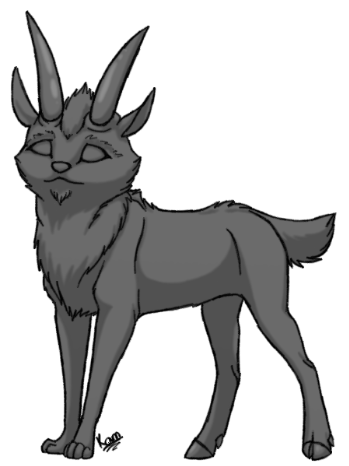Appearance
Males and females are about the same size. Each grows to an adult height of about 2 feet.
Unlike their Goennec cousins, there is much less variety in their general appearance.
Males have longer horns than females and sport a small goatee.
An Arbex will always have only one pair of hooves and one pair of paws. Hooves always on the hind, paws always on the fore. The forepaws aid in scraping through ice and snow to get to the shoots buried underneath. and the hooves, built like an Ibex's give an excellent hold on steep rocky slopes. If one were to be born with two of either, it would either not be able to forage for food in winter months and thus starve, or it would not have a good enough hold on the mountain cliffs and likely fall to it's death.
They have three tufts of longer fur, reminiscent of their relatives' full mohawks. One running from between the horns to the base of the skull, a second at the shoulders, and a third starting at the hips that runs into the tail. Very rarely one will be born without this, though those without it will often be found less desirable as a potential mate.
The tail is short, but full. There will never be one without this type of tail.
The ears are goat-like.
In the winter, the Arbex will grow a thick, warm coat to shield it from the elements.
The body build is much like an Ibex, but the head, neck, and forelegs are like an Arctic fox.
Arbex will always have a light, neutral base (grays and browns), but not pure white. Markings can be any color accept lighter than the base color and can be anywhere and in any pattern.
The eyes are a darker version of the base color.
Variations are very rare, but are can occur. They include:
Dark base with light markings
Pure white base
Eyes that do not match the base
no tufts
full bob (rather than the characteristic longer bob)
 |
|
Behavior
As a youngster, an Arbex will stay with it's mother until it is weaned at six months old. from then until it reaches it's full maturity at two years, it will behave much as the does of the herd do, not taking much interest in the struggle to reach dominance as the adult males do. When they do reach maturity, the does will continue to stick with the older does. Males will start competing with each other, slowly working their way from younger rams to the older, more dominant rams. Unlike Goennecs who usually only fight during the breeding season, an Arbex will be on the lookout for a challenge all year round, though the matches are generally spaced fairly well and once two males have fought, they will not challenge each other again.
Because of this way of life, herds consist of groups of harems as well as the unlucky bachelors who have failed to catch any female's attention. Herds are rarely smaller than 20 individuals and can expand to nearly 50, though herds of that size often do not maintain that size for very long.
Arbex are migratory creatures. Summers are spent in the far north, on the tundra. Winters are spent in the mountains, further south. They only live in the northern hemisphere, near the arctic circle. An Arbex will never be found further south than 30 degrees latitude.
Migratory paths are instinctive, though if a road block occurs, the more dominant males in the herd will together decide on how to go about getting back on track.
There is no one dominant leader of the herd. Decisions are made based on the input of five or so of the most high up rams.
Lifespan is usually about 40 years for males, 45 years for females.
Diet
Arbex, like Goennecs, are omnivorous opportunists. Much of the time, they forage for shoots and leaves, but the occasional rodent or two is a welcome treat they won't hesitate to go for.
Favorites are always wildflowers, but they're known to get by on just roots through the harshest of the winter.
 |



